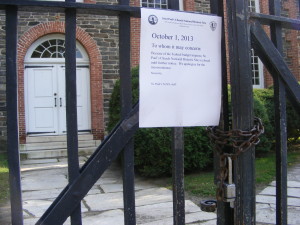The gates to St. Paul”™s Church in Mount Vernon were closed, chained and padlocked Oct. 1, the first day of the federal government shutdown. A worker had Scotch-taped a typed letter to the wrought iron, its font size small enough that it was only legible from up close.
“Because of the budget impasse, St. Paul”™s Church National Historic Site is closed until further notice,” the letter stated.
The church, with its Revolutionary War-era bell tower and historical cemetery, is the only site in Westchester County operated by the National Park Service. Its closing did not draw crowds of disappointed tourists like those 20 miles away at the Statue of Liberty nor did it inspire protests like those at Washington”™s World War II monument. But it served as a physical example of the immediate impact of the federal shutdown on Westchester and as a symbol of more significant problems for the county just below the surface.

Thomas Morley is the director of the Rockland Small Business Development Center, a center that offers technical assistance for small business owners and entrepreneurs in Putnam, Westchester and Rockland counties. The first days of October would have been a busy day for the center anyway, with the rollout of Obamacare health exchanges. The shutdown only complicated things, Morley said, because navigators were furloughed and the health care law is the basis of the fight. In the first days of the plan, he has been answering the calls of local businesses needing guidance on how to comply with the requirements of the new law.
“No one is sure what is going on,” Morley said. “If I had to pick a term at this point I would have to use ”˜confusion”™ ”¦ Everything was changing and no one is here to do the change.” Morley has been advising owners of the current requirements, but reminding them the situation is fluid due to the shutdown. “The biggest impact is (the shutdown) is coming at the worst time, during a sea change in this country,” he said.
In the short-term, the operations of the center and others like it won”™t be affected by the shutdown as they are have funding contracts and work in collaboration with state and other non-federal agencies.
One of the center”™s functions is guiding owners through the federal Small Business Administration program, which guarantees loans for small businesses and entrepreneurs and seeks opportunity for minority, women and veteran owners. The SBA is shut down, though its website is one of the few government sites still active. During the shutdown, applications are not being processed which means no new SBA loans can be accepted. Morley said the center assists with hundreds of loans per year, meaning a few are filed each day. When the shutdown ends, that means a backlog and a possible logjam.
“The folks that I will feel for the most would be the people who have an SBA package in progress as it is,” he said. No paperwork is being processed and that could mean a lengthened approval timeline or in certain cases, more expenses. When applying for an SBA-backed loan, a small business owner often has set deadlines from lenders or preparers. For example, financial statements may be due within 30 days or an appraisal might need to be approved within a timeframe usually under 90 days. A prolonged shutdown could mean missing deadlines, re-filing and maybe even needing a new appraisal. If a rate change kicks in during a new process, it is possible a business owner could lose his or her original agreed-upon loan rate.
The Internal Revenue Service is partially shutdown as well and won”™t be processing the 4506 form, which authorizes the government to share an applicant”™s earnings information. Not only will business owners be affected in this regard but people who are applying for mortgages and even rent who authorize income verification from the IRS.
During the shutdown, Morley said the center would advise current applicants about potential deadline conflicts and also help new applicants get their paperwork lined up for the grand reopening. “It”™s an out of office kind of thing,” he said. “Folks can continue to file paperwork.”
This is the 18th government shutdown since the U.S. adopted its current budgeting process in 1976, according to the Washington Post (prior to a legal opinion in the 1980s, a lack of funding approval did not mean that federal agencies actually suspended their daily functions). The longest shutdown to date was the most recent, lasting 21 days from December 1995 to January 1996, with its fallout being the Clinton impeachment and the eventual toppling of the House”™s Republican leadership.
U.S. Rep. Nita Lowey, a Harrison Democrat, called the current shutdown “the Republican shutdown” based on the House GOP”™s stance of tying Obamacare to a continuing resolution for the budget. “The Republicans have lost the battle on health care and their response was to shut down the government,” she told reporters on a conference call last week. Lowey said her office had received calls from furloughed employees in the Hudson Valley and a resident who depends on Social Security checks concerned about his income.
More than 800,000 federal employees are furloughed and an extended shutdown may see those numbers go up. U.S. Rep. Sean Patrick Maloney, a Putnam Democrat, said he would be furloughing an unspecified number of his staff.
“Even as I continue efforts to end the irresponsible manufactured crisis that puts our economy at risk, Congress should not exempt itself from a government shutdown ”“ and that includes my staff,” he said in a written statement.




















